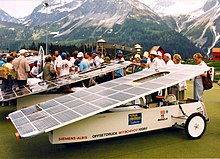Tour de Sol
The Tour de Sol was the first race for vehicles that drove with a solar drive instead of an internal combustion engine . The event was originally planned by the initiator Josef Jenni as an advertising campaign for solar energy and was recorded by Markus Heimlicher, the managing director of the Swiss Association for Solar Energy (SSES). With this campaign, the SSES wanted to show that solar energy does not only work in hot areas, but also in Switzerland. The organizer was the engineer and solar entrepreneur Urs Muntwyler (from 2010 professor for photovoltaics at the Bern University of Applied Sciences), who carried out almost all of the annual events between 1985 and 1993 and organized regular exhibitions, conferences and related printed matter. The legal form was a foundation that existed until 2002.
The first Tour de Sol was held in Switzerland in 1985 . It led in 5 stages from Romanshorn via Winterthur to Geneva . At the start there were 73 solar vehicles and 58 of them made the route, which took place on open roads; the participants had to adhere to all traffic regulations. The winner was the solar vehicle Mercedes-Benz / alpha real from the automobile manufacturer Mercedes-Benz and the Swiss engineering office alpha real from the engineer Markus Real. The vehicles had solar cells and batteries with a defined maximum output (480 Wp) or capacity (Wp x 10 h).
Initially, two categories of vehicles were permitted:
- Solar vehicles without additional drive, d. H. operated exclusively with direct solar energy, plus the first charge of the battery. A maximum of 6 m² or 480 W was allowed for the solar generator and 4.8 kWh for the battery.
- Solar vehicles with additional drive, d. H. with additional muscle power and with reduced values for solar generator and battery.
Other categories were added later, e.g. For example: "Series solar vehicles", series-compatible prototypes or actual electric cars with regular traffic approval. Since the available solar surface was too small for such vehicles, stationary solar charging stations with battery replacement and later the network system were approved: the vehicles were allowed to charge from the power grid if, mathematically, enough electricity was fed in elsewhere. This led to the feed-in systems for solar power known today.
The second Tour de Sol led from Freiburg im Breisgau ( Baden-Württemberg ) to Suhr AG ( Aargau ). The fastest solar vehicles without additional drive reached a top speed of 120 km / h. The average speed was 49 km / h.
Other events of the Tour de Sol were:
- 1987: Biel - Arosa
- 1988: Zurich - Etoy VD
- 1988: the first solar boat race in Estavayer-le-Lac.
- 1989: Contone - Rheinfelden AG
- 1990: Schaffhausen - Münsingen BE
- 1990: Tour de Sol Alpine (on snow): Lenzerheide / Lai - Valbella
- 1991: Suhr AG - Beatenberg
- 1991: Tour de Sol Alpine (on snow): Lenzerheide / Lai-Valbella
- 1992: Pforzheim ( Baden-Württemberg ) - Saas-Fee
- 1991 Tour de Sol Alpine (on snow): Arosa
- 1993: Lucerne - Adelboden
While the vehicles mostly had three wheels in the first races, more and more four-wheeled cars and two-wheelers were added later. From the latter, the first commercial series of electric motorcycles and electric bicycles emerged in Switzerland.
The Northeast Sustainable Energy Association (NESEA) also ran a solar car race in the USA under the name American Tour de Sol .
Sources and web links
- Two radio broadcasts for the 30th anniversary
- Interview with Josef Jenni in 2008
- Video of some Tour de Sol 85 vehicles
- [1] The same video and many others on Youtube
- Publications on the Tour de Sol including regulations in the Helveticat catalog of the Swiss National Library
- R. Reichel: Tour de Sol, new start to electric vehicles 30 years ago , EMobile plus solar No. 97 - summer 2015, pp. 5–13
- Pictures at the stage destination St.Gallen from 1987
